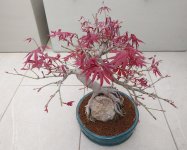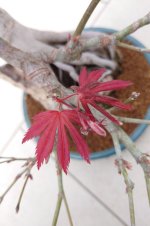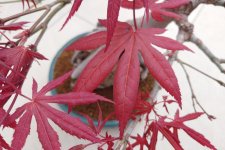Yamamomiji
Seedling
I found myself lucky in acquiring this Japanese maple over rock in the winter a few months back.
It comes from a liquidation of a collection and it was just labelled as an ordinary Acer palmatum (which it clearly is not).
Now, when the buds came through and finally broke I had some pretty colourful red in front of me but I doubt that it is something of the more common Deshojo.
Browsing through the Vertrees' Japanese maple book, I found some matches but still unsure.
This tree is still a young one I guess, which left the state of primary design some time ago and now the journey goes on with the branching. The leaves are quite uneven in size for now, some balancing will come in time I guess. The leaf in the last picture is nearly 11 cm in width, whereas the others are smaller, more at about 4 - 6 cm.
From my point of view, it might be some sort of Atropurpureum, Fireglow, Oregon Sunset, and I do not expect any turning green and the red is of a darker tone (compared to my flaming pink/rosé Beni Chidori).
What would you guess?
It comes from a liquidation of a collection and it was just labelled as an ordinary Acer palmatum (which it clearly is not).
Now, when the buds came through and finally broke I had some pretty colourful red in front of me but I doubt that it is something of the more common Deshojo.
Browsing through the Vertrees' Japanese maple book, I found some matches but still unsure.
This tree is still a young one I guess, which left the state of primary design some time ago and now the journey goes on with the branching. The leaves are quite uneven in size for now, some balancing will come in time I guess. The leaf in the last picture is nearly 11 cm in width, whereas the others are smaller, more at about 4 - 6 cm.
From my point of view, it might be some sort of Atropurpureum, Fireglow, Oregon Sunset, and I do not expect any turning green and the red is of a darker tone (compared to my flaming pink/rosé Beni Chidori).
What would you guess?










